
Any maintenance or asset manager knows that the longevity of assets is critically dependent on how well they are maintained. And you don’t have to be a maintenance manager to know that your car needs regular servicing. It is kind of obvious! Yet, when it comes to the important public infrastructure on which we all depend, maintenance is considered dispensable and is the first to be cut in times of financial stringency.
It is all to do with how we account for infrastructure assets. Below is the problem – and how we can overcome it using your asset management plan and condition based depreciation (CBD).
The Problem
It pays to know a little history. When government departments and agencies adopted accrual accounting practices and had to bring infrastructure assets to account for the first time, (In Australia, from 1989) naturally they turned to the private sector, where this had been the practice for many years. And this is where the first problem arose since private sector assets such as plant and machinery are depreciated over their predetermined lifespan until they reach zero or some predetermned salvage value and then they are completely replaced.
Infrastructure assets are different. This does not happen with infrastructure assets which can be kept in service for an indefinite time by piecemeal, if somewhat lumpy, component renewal. What is the age of an asset which may have some components 100 years old and others that were renewed yesterday? What is the life of an asset that can be kept in service as long as you want it to? These are unanswerable questions. They go to the heart of the difference between infrastructure and non-infrastructure assets and require a different accounting approach.
However when infrastructure assets were first brought to account, there was no alternative accounting approach for infrastructure assets, so rather than account for the entire infrastructure system, it was decided to assign each component a definite life and depreciate it as if it were an independent asset. It seemed a practical solution to a difficult problem. But in the process it completely ignored the key characteristic of infrastructure assets which is the interdependence of the components, where the life of a component, and thus the need to renew, is dependent on the other components with which it interacts. In other words, the life of components is indefinite, as is the life of the system as a whole. This does not mean infinite! It just means that you cannot define a life of a component until it reaches the stage of renewal. So depreciation in this case doesn’t work.
You will also notice something else about this approach. The economic life of any asset, as we stated at the beginning, depends on how well it is maintained, and yet maintenance does not feature in this accounting process. This is what makes it so easy for organisations to cut maintenance, since cutting maintenance does not affect the life of the asset, at least not in the accounting system – only in the real world!
The Solution
We need a better system, one that takes equal account of maintenance (minor and major) and renewal, i.e.everything that we need to spend to maintain the functionality of the asset. (In practice ‘maintenance’ and ‘renewal’ are really just different points on a continuum.)
Why do we depreciate assets at all? It is so that we can represent reduction in asset value in any particular period (asset value = its store of future services)
Is there a better way of doing this that recognises the distinct character of infrastructure assets? There is! What better way can there be of valuing the using up of asset services than the cost of making it good again? This is what is called Condition Based Depreciation (CBD). And it is available to any organisation that has a sound, and audited, AM plan as a costless spinoff. Put simply, the condition assessment of your assets that tells you what you need to spend over the planning period to maintain service function and that is in your AM Plan. It covers maintenance, minor and major and renewal and is the cost of making good the consumption of the asset over that period. You choose your planning period and it is updated on a rolling annual basis. The cost of ‘making good’ over the planning period is then expressed as an annuity to give you an annual cost and is the best estimate of real depreciation.
Second history lesson: When the UK water industry was being privatised in the early 1980s the argument was put forward that their assets should not be depreciated because the assets were continously maintained. This was rightly rejected by the accounting profession who said, in effect, ‘prove it’ and that is what a sound, audited AM plan does. Unfortunately some do not recognise the distinction between this and the AM plan backed CBD.
CBD was introduced in 1993 and has been well received by maintenance and asset managers and by practising accountants. It was adopted by the NSW Roads authority and by about a half of NZ’s councils for about ten years (until their accounting society called a halt). It is even provided as the ‘modified’ approach in GASB 34, the standard that introduced accrual accounting into the USA in 1999 but it was rejected by the Accounting Standards Board in 2004 and nothing much happened for the next 13-14 years!
Now it is back into contention because of problems with asset valuation giving depreciation figures that are artificially high and causing councils to be deemed non-viable. These councils are now scrambling to make cuts to their budget, eliminating services and sacking staff – and all at a time of Covid 19! So fictional figures are giving rise to real – and negative – physical effects. We can do better, much better!
Would CBD help bring your maintenance to the fore?
Extra references on CBD
Condition based depreciation for infrastructure assets, 1993
Depreciation of infrastructure assets
Condition based depreciation – the questions
- Extra information is provided here.
- Ask any questions you like and I will answer all of them.
To ask questions and to find out more about a national forum to develop support for adoption of CBD, use the comments section below. (There is global interest in this subject, so we might extend it to a global forum.)

The Innovation Delusion: How Our Obsession with the New has Disrupted the Work That Matters Most, Lee Vinsel and Andrew L Russell (September 2020)
Is this the first ‘popular’ book on Asset Management & Infrastructure Decisions? You wouldn’t necessarily know from the title.
But maintainers and asset managers are the, well, not heroes here: Vinsel and Russell describe ‘infrastructurers’ as something better than heroes. ‘The people who care about things’, as Lou Cripps puts it. And infrastructure in terms of human rights.
The book is a sustained attack on ‘bright, shiny new things’, especially when they really are not worthy of the name innovation, and when they will land communities in debt and ‘deferred maintenance’ for many years.
“Although you wouldn’t know it from histories that fixate on innovation and inventors, much of human history is, in fact, stories of stability: of how societies coordinate labor to maintain the large-scale public systems we’ve relied on since ancient times.”
But the authors are not simply academics, or popularisers. With Jessica Myerson, the authors have set up The Maintainers, https://themaintainers.org/connect. Their vision is:
“Through collaborative efforts across an interwoven network of communities, we pursue our mission of maintaining self and society through reflection, research, and advocacy in the hopes of achieving a more caring and well-maintained world.”
The book itself is a good read, using the current ‘popular’ non-fiction style of stories around individuals: everything you’ve ever worried about with poor rail track maintenance and failing water systems, and some good people trying to sort them.
I suspect it’s generally true that, when you know the inside story, things are not always quite as simple as written. I was a ‘fly on the wall’ at PG&E over the time of Camp Fire, and I don’t buy that wildfires should be blamed on ‘somebody else’, or one company’s profits alone, for example.
But, with honourable mentions for reliability engineers, Ursula K Le Guin, Melinda Hodkiewicz, and even ISO 55000 – and even computerised maintenance management systems! – this is my kind of territory.
Your reviews of it are most welcome here.
And what do you think about essential infrastructure as a basic human right?

In the last post I suggested that it might be time we changed our thinking on major issues like nuclear disarmament. But perhaps it is also time we changed our ideas on how we try to convince anyone to change anything!
I am indebted to Kerry McGovern for the following idea. She spoke of a friend who had argued that when introducing a new and controversial idea, 3% of the population are already of this opinion and do not need you to tell them, 7% are almost there and can be easily convinced, and about 30% recognise that they don’t know enough but are prepared to find out, the next 30% are too busy doing other things, and the last 30% are going to oppose you no matter what. Her advice is forget that bottom 60% and concentrate first on networking with the 3%, bringing in the 7% and then, as a group addressing the next 30%. I don’t know the source of the figures but the general idea is attractive. Moreover, working on these figures, once we have captured the 37%, assuming that the middle ‘busy’ 30% are neutral, we now have a majority on our side!
So often, we focus on the bottom 60% and see the issue as an ‘us and them’ antagonistic confrontation. But what if we were to look instead at the top 40% and see the issue as one of collaboration? Would not that be generally happier and more productive?

Recent Comments